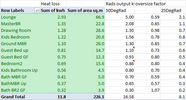I have a 19 kW non condensing oil boiler for a 5 bedroom detached house with three floors, it can maintain the house with no problem, but heating from cold is another story.
So the work around was not to heat all rooms together, we have programmable TRV heads in most rooms, and we like the house to cool over night, and then warm up through the day, the hall is kept cooler than the living room, and if we leave the house the main thermostat auto turns down the heating. (Geofencing)
However on return reheating can take a couple of hours, unlike our old gas fired system, this one uses micro bore piping and although temporary turning down rooms not in use will speed up heating of used rooms, we find the boiler then starts to cycle, where with the old house we had no idea to if the boiler was modulating, it was running but no idea if at 10 kW or 28 kW there was nothing on the boiler to tell you. (Worcester Bosch)
But the point is the losses are nothing when compared with re-heat time. OK now retired so rarely leave the house so geofencing not used much, and using times can work out far better as you can set kitchen, then dinning room, then living room, and after a large delay bedrooms, so all rooms not re-heated together, and this worked with old house, but not with this house to same extent as the radiators in main rooms are not big enough to sink all the energy the boiler can produce.
But unless you live in a care home, it is unlikely you want the same temperature 24/7 in all rooms, so looking more at re-heat time to what losses there are.
As to domestic hot water that is likely part of my problem, as I can't control how much energy goes to heat it, using C Plan and no valve of any sort to turn it off, summer it is heated with solar, using an iboost+ it uses solar once everything else is satisfied, so no longer run boiler in the summer.
I think my problem can be cured with a second thermostat in the living room in parallel to one in the hall, but wife deciding she wanted kittens has messed up the central heating, as they scratch at closed doors, and leaving doors open upsets the balance between rooms.




